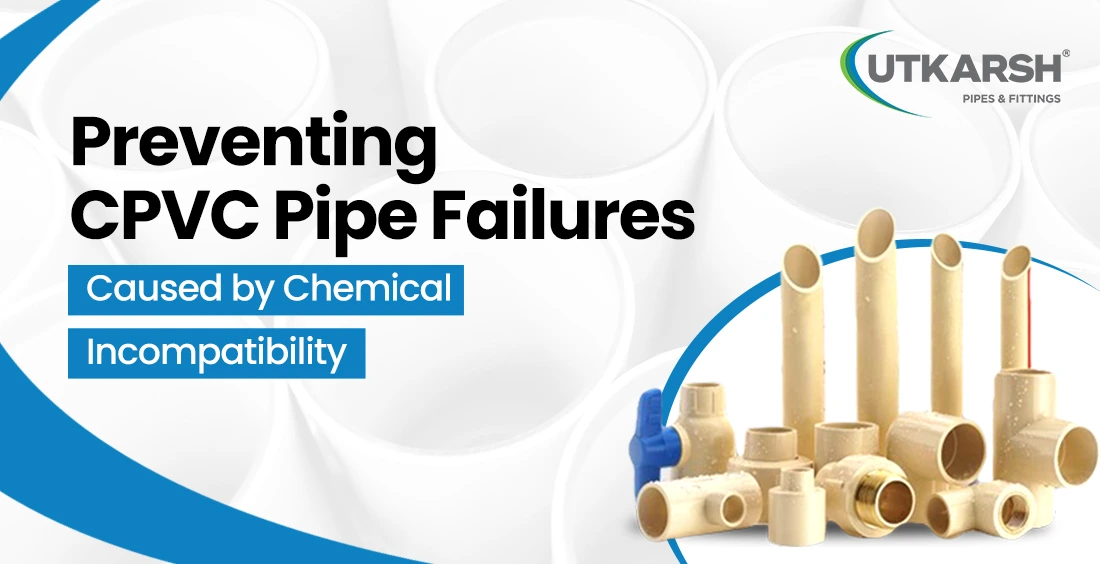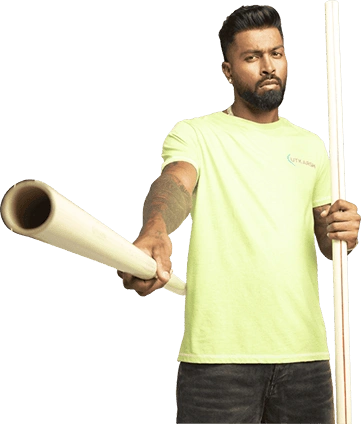Preventing CPVC Pipe Failures Caused by Chemical Incompatibility

Every homeowner, builder, or contractor expects their plumbing system to last for years without worry. Yet, one of the most frustrating issues faced today is CPVC pipe failure - often occurring not because of poor installation, but due to unseen chemical incompatibility.
When certain chemicals come into contact with CPVC pipes and fittings, they can cause the material to weaken, leading to cracks, leaks, or even complete pipe failure. This is not only costly to repair but can also disrupt entire water supply systems, especially in residential and industrial applications.
At Utkarsh Pipes and Fittings, we understand these challenges deeply. Our CPVC plumbing systems are engineered and tested to withstand aggressive environments and prevent failures linked to chemical exposure.
Understanding the Causes of CPVC Pipe Failure
CPVC (Chlorinated Polyvinyl Chloride) is widely valued for its heat resistance, durability, and corrosion-free nature. However, even the most robust CPVC plumbing system can experience CPVC pipe failure if exposed to incompatible substances, improper installation practices, or environmental stressors. Understanding these causes is key to preventing damage and ensuring long-term performance.
1. In Contact with Incompatible Sealants or Lubricants
Some thread sealants, pipe joint compounds, and lubricants contain petroleum-based or solvent chemicals that attack CPVC surfaces. These substances can soften the pipe material, causing micro-cracking that eventually leads to pipe failure.
2. Exposure to Heavy Household or Industrial Chemicals
Products such as cleaning agents, insecticides, or industrial solvents can release vapors that come into contact with CPVC pipes and fittings. Prolonged exposure may result in stress cracking, especially in confined areas like utility rooms or mechanical enclosures.
3. Improper Storage and Handling
Sometimes, chemical incompatibility in CPVC pipes begins before installation. Pipes stored near volatile chemicals, paints, or contaminated surfaces can start degrading early, compromising long-term durability.
4. Incorrect Material Pairing
Combining CPVC pipes and fittings with incompatible metals or other polymers during installation can trigger chemical reactions, weakening the system and causing premature failure.
5. Thermal Expansion
CPVC naturally expands and contracts with temperature fluctuations. Without proper allowance for thermal expansion during installation, pipes can warp or crack, leading to reforming cracks in plumbing pipes and potential leaks.
6. Failed Application of Solvent Cement
Solvent cement is critical for joining CPVC pipes and fittings. Improper application—too little, too much, or uneven spreading—can create weak joints, increasing the risk of pipe failure over time.
7. Untrained Plumbers
Incorrect installation techniques, such as over-tightening, cutting at improper angles, or failing to follow manufacturer guidelines, can accelerate CPVC pipe failure, even if the material itself is of high quality.
8. Lack of Maintenance
Neglecting regular inspection and maintenance can allow minor cracks or chemical exposure to develop into major failures. Proper care of your CPVC plumbing system is essential to prevent costly replacements.
Pipe Failure Analysis: Understanding the Damage Mechanism
Through pipe failure analysis, experts can identify whether chemical incompatibility was the root cause. The typical signs include:
Discoloration or surface softening of the CPVC material
Hairline cracks or brittleness
Leakage at joints even after proper tightening
Loss of mechanical strength over time
How to Prevent CPVC Pipe Failures Caused by Chemical Incompatibility
Preventing CPVC pipe failure is not just about installation - it’s about choosing the right materials, handling them correctly, and relying on products engineered to withstand chemical and thermal stresses. Utkarsh Pipes and Fittings ensures that every CPVC plumbing system delivers unmatched durability through advanced engineering and rigorous quality testing. Here’s how:
1. Use Chemically Compatible Sealants and Adhesives
Only use sealants, cements, and lubricants that are certified for CPVC pipes and fittings. Avoid petroleum-based or solvent-heavy products that can weaken the pipe and trigger chemical incompatibility in CPVC pipes.
2. Ensure Safe Storage and Installation Environments
Keep CPVC pipes away from chemicals, paints, and industrial solvents during storage and installation. Exposure to vapors or residues can cause micro-cracks and stress failures over time.
3. Rely on Professionally Trained Installers
Even high-quality pipes are vulnerable if installed incorrectly. Using trained plumbers ensures proper cutting, joining, and alignment, reducing risks like reforming cracks in plumbing pipes or joint failure.
4. Conduct Periodic Pipe Failure Analysis
Regular inspections allow early detection of chemical, thermal, or mechanical stress in industrial or commercial systems. Early intervention prevents minor issues from escalating into major CPVC pipe failure.
5. Choose Pipes Backed by Quality Tests
Utkarsh CPVC pipes and fittings undergo advanced tests to guarantee long-term reliability:
Oxidation Induction Time (OIT) Test – Confirms thermal stability and material longevity.
Non-Toxin Test – Verifies pipes are safe and chemical-free for drinking water applications.
Crack Test – Pipes are exposed to extreme pressure to ensure resistance to fractures and sudden shocks.
Vicat Softening Temperature Test – Determines the softening point to ensure performance under high temperatures.
6. Follow Correct Maintenance Practices
Routine maintenance and careful monitoring prevent long-term chemical or thermal damage. Promptly addressing minor cracks, leaks, or exposure ensures the CPVC plumbing system continues performing reliably.
Why Utkarsh Pipes Lead the Way
At Utkarsh Pipes and Fittings, every product is designed with engineering precision and backed by strict quality checks. Our CPVC pipes and fittings are manufactured using premium raw materials and advanced extrusion technology to resist chemical incompatibility and mechanical stress.
By aligning our manufacturing standards with global benchmarks, we ensure our customers enjoy long-lasting, leak-proof, and maintenance-free CPVC plumbing systems.
Conclusion
Chemical incompatibility remains one of the most overlooked causes of CPVC pipe failure, yet it’s entirely preventable with the right choices. From proper material selection to careful installation and maintenance, each step plays a vital role in system longevity.
With Utkarsh Pipes and Fittings, you can be confident that your plumbing infrastructure is built to last - resistant to both chemical and environmental threats.
Choose Utkarsh. Choose Reliability.











